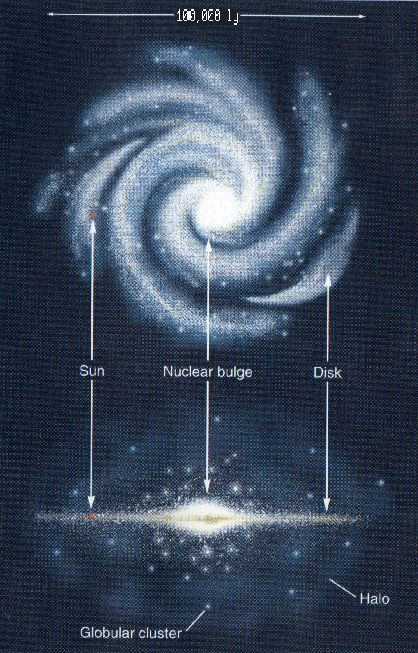The VBLA is made up of ten, remotely operated, 25 meter, inter-connected radio telescopes, spanning a distance greater than 5,000 miles. This makes the VLBA the largest, and sharpest radio telescope to date.
 |
| Image courtesy of NRAO/AUI and Earth image courtesy of the SeaWiFS Project NASA/GSFC and ORBIMAGE |
Find an Astronomy text more than ten years old, an easy feat in many schools, and you will see Pluto is still a planet, and that our galaxy looks like a pretty plain old ordinary spiral with several arms
 |
| http://casswww.ucsd.edu/archive/public/tutorial/MW.html |
Fast forward to 2005. Astronomers, using the Spitzer Space Telescope, discover that our galaxy is actually a much more exciting variety of spiral, called a barred-spiral.
And, according to NBC News, it loses a couple of arms. Here is the artists conception of what research had indicated our galaxy looked like at that time, including our location within it.
 |
| NRAO |
As you can see, we seem to occupy a pretty insignificant spot located between the major arms of the galaxy. This region is referred to as the Orion Spur, or Local Arm. I'll get back to that later.
During the 2000s, other discoveries concerning our galaxy were made; including it's mass.
Of around 30 galaxies, there are two heavy hitters in our Local Group; the Milky Way, and the Andromeda Galaxy. For a long time, it was believed that the Andromeda Galaxy was much larger, and more massive. A study in 2006, using
the Very
Large Telescope in Chile, along with another study in
2009 using VLBA data, revealed that the Milky Way, and Andromeda actually have a similar mass, within the margin of error, when the elusive dark matter is taken into account. This news prompted a response
worth watching
The VLBA was continuing to provide very accurate data about distance and motion of several regions of the galaxy that reinforced the spiral structure of the Milky Way, and it seemed to even suggest that our galaxy may have four spiral arms, as opposed to the two that were generally accepted. This four arm model suggestion is not with out controversy however. Even as I write this, I am Tweeting an astronomer friend, currently at Cal Tech, concerning the structure of the galaxy
The conversation answered one question, but left me with at least one other. Pseudobulge?
.
During the second half of the 2000s, we had a good idea of the structure, and mass. Surveys coming in from the Spitzer Space Telescope, launched in 2003, indicated that older stars reside mostly in the two main spiral arms. This led to questions, and further study into why older stars do not appear in all of the arms. Research continued, and more detailed observational data was collected and analyzedThis brings us to the most recent discovery, and the announcement concerning the size of the Local Arm. The exquisite details about the motion and distance (through parallax) of objects in our galaxy that the VLBA was gathering, began to cause scientists to revisit the nature of our own galactic backyard. The idea that we occupy a tiny Spur, located between two spiral arms, now seems to be wrong. According to Alberto Sanna, of the Max-Planck Institute for Radio Astronomy
"Our new evidence suggests that the Local Arm should appear as a prominent feature of the Milky Way...Based on both the distances and the space motions we measured, our Local Arm is not a spur....It is a major structure, maybe a branch of the Perseus Arm, or possibly an independent arm segment."
Before
After
This current research finding is the result of VLBA data collected between 2008 to 2012. It was presented at the 222nd meeting of the American Astronomical Society. The results hit the social media circuit immediately
The discovery of the size and structure of the Local Arm, was the next step in better understanding the galaxy in which we live.
The problem today, is the same as it was during Herschel's time. What is the structure of our galaxy, and where are we within it? During the past century, we have made significant progress in understanding our place in the universe. As telescopes improve, along with our computing power, that trend should continue. The next phase is to continue the observations of the VLBA, and compare them with other high performance telescopes, like ALMA , and project observations of other parts of the galaxy, like Penn State's APOGEE, and SDSSIII
The research question that I would propose next would require developing software to run supercomputer simulations of the new data in order to explain the origin and development of the Arm, and make predictions concerning the amount, and distribution of star forming materials, and formation rates, in order to determine if this is a long or short lived structure.








No comments:
Post a Comment